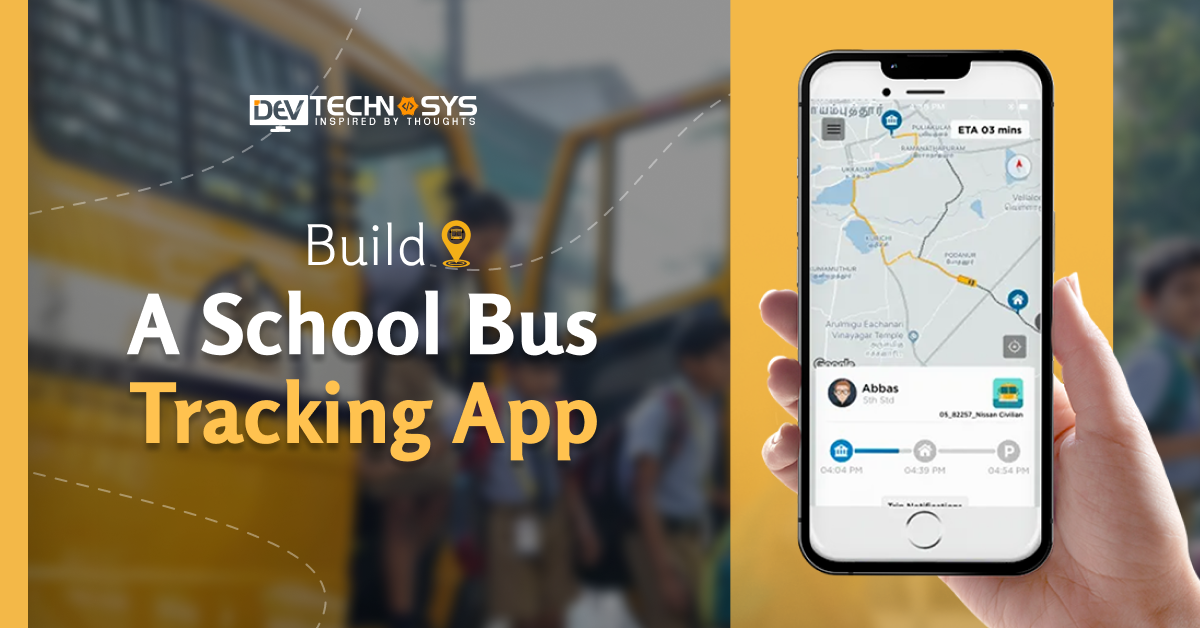“Ensure the safety of students by developing a school bus tracking application.”
Navigation systems are being used in multiple domains like food and courier delivery, healthcare, and education. Their contribution at the school level is remarkable. The race to build a school bus tracking app encouraged institutions and other businesses to invest in this industry.
There are several benefits linked with school bus tracker apps helping school officials, students, and even parents. So, it is a profitable idea to create a school bus tracking app at affordable rates. You need to understand various topics regarding the development process.
So, in this blog we will help you to understand different aspects like the need to make a school bus tracking app, working, features, cost, and monetization in detail.
Why Do Schools Need a Bus Tracking System?
A bus tracking system improves the dependability, efficiency, and safety of school transportation. It ensures a safe and efficiently run transportation system by keeping parents, school officials, and drivers updated on bus positions in real time.
![]()
1. Student Safety
Students’ safety is guaranteed by a GPS-based bus tracking system that provides real-time location updates. You can develop a location-based app that can track the bus’s route and arrival time, helping school personnel lower the possibility of unapproved routes.
2. Route Monitoring
Schools can cut down on travel time and fuel expenses by optimizing bus routes through the analysis of traffic patterns and route data. You can make a school bus tracking app to guarantee that pupils get to school and home more quickly and effectively.
3. Better Communication
Bus arrivals, delays, and route modifications are immediately communicated to parents. A mobile app development company may help you to promote a more structured transportation system by improving communication between parents and schools.
4. Administrative Services
Real-time bus movement monitoring by school officials ensures adherence to safety rules and schedules. It also facilitates prompt reaction to crises or malfunctions.
5. Fuel Efficiency
Schools’ operating expenses are decreased by improved fuel management and route optimization. Businesses can assist schools to reduce fuel and maintenance costs by using geolocation app development services.
How Does a School Bus Tracking App Work?
Real-time bus location updates are provided via a school bus tracking app, guaranteeing student safety and effective transit. For a smooth experience, it improves communication between drivers, parents, and schools.
![]()
1. GPS Activation
The application allows for real-time location tracking by integrating with GPS units mounted in school buses. This makes it easier for parents and school personnel to precisely track bus movements.
2. Decide Route
The system recommends the optimal routes after analyzing traffic conditions. The use of GPS tracking app development services can help you to reduce delays and guarantee effective transportation.
3. Updated Bus Status
Bus arrivals, delays, and route modifications are instantly communicated to parents and school administration. This removes doubt and improves communication.
4. Mark Attendance
Students can use smartphone apps or RFID cards to mark their attendance. Businesses can hire dedicated developers to stop unwanted access and guarantee accurate attendance tracking.
5. Generate Emergency Alerts
Parents and schools are immediately notified by the app in the event of crises or malfunctions. This enables prompt action to guarantee the safety of students.
6. Student Reporting
Targeting navigation app development solutions offer thorough reports on driving performance, fuel usage, and routes. This data can be used by schools to cut expenses and increase efficiency.
Essential Steps to Build a School Bus Tracking App
You will now understand the process to build a school bus tracking app in this section. So, cost management, app launch, tool section, and maintenance will become easy:
![]()
1. Analyze the Market
Perform in-depth market research to understand GPS tracking app development services based on various requirements. This includes parents, schools, and transportation providers. Determine the main features to develop a school bus tracking app by examining user reviews and identify competitors.
Knowing the needs and problems guarantees that your software successfully satisfies practical requirements. Evaluate rules and compliance requirements for student transportation tracking.
|
● What is the need to develop school bus tracking apps? ● What are my target audiences? ● Is it easy to develop a GPS navigation app? |
2. Create an MVP
Before releasing the full-scale program, you can test key features by creating a Minimum Viable Product (MVP). Important features like GPS tracking, route optimization, notifications, and parent-school connectivity should all be included in an MVP.
By first releasing a rudimentary version, you can gather user input and adjust the version as necessary. This method guarantees a more polished end result while reducing hazards.
|
● What is MVP development? ● Can I identify necessary features with MVP? ● Why is it important to develop an MVP? |
3. Hire Development Partner
Businesses can approach a GPS tracking software development company to successfully develop a school bus tracking software. Either an experienced app development company, freelance developers, or an internal team might be hired.
Make sure the group is knowledgeable with cloud computing, security procedures, and GPS-based apps. You may create a scalable and user-friendly application with their help.
|
● From where I can hire a GPS app development company? ● What is their role in the mobile app development process? ● Do they ensure confidentiality and credibility of the idea? |
4. UI/UX Designing
For parents, school administrators, and drivers, a well-designed interface improves user experience and makes navigation simple. Make sure that monitoring tools, alarms, and reports are easily accessible by concentrating on developing a simple and engaging design.
Different user groups should be served by the UI/UX, guaranteeing smooth interactions on both online and mobile platforms. It can increase engagement, give usability, and accessibility.
|
● How can I build a multi-panel application? ● Is it useful to take help of AI-powered design tools? ● What are the major designing languages? |
5. API Integration
This mobile application development process requires API interfaces in order to provide real-time tracking, notifications, and seamless communication. Include cloud storage, push notification systems, geofencing, and GPS tracking APIs such as Google Maps.
For seamless data synchronization, make sure the app can interface with school management systems. Ensuring system stability and protecting data privacy require secure APIs.
|
● What APIs are useful for tracking user location? ● Is it easy to implement payment APIs? ● How to store a large amount of user data? |
6. Test & Launch
Thorough testing is necessary before launch in order to find and address errors, improve performance, and maximize security. Perform a variety of tests, including as user acceptability, performance, and functional testing. To get feedback and make changes, soft-launch the app with a small group of users.
Deploy the software on the iOS and Android platforms after it has been tested and improved to guarantee a seamless launch.
|
● What is the role of Beta Testing? ● Why is application launch important? ● How can I perform marketing of bus tracking apps? |
7. Post-Development Services
Maintaining the app’s functionality and security requires regular upgrades and maintenance. To improve features and security, you must avail mobile app maintenance service and offer customer satisfaction with prompt updates. High user engagement is based on requirements and technology developments.
Providing post-launch services also helps to gain user trust and guarantees high productivity of school bus tracking applications with high security.
|
● What security measures are necessary for data privacy? ● Is maintenance cost added with total development rate? ● Why are feature updates mandatory? |
Key Features of School Bus Tracking Apps
A school bus tracking app maximizes transportation efficiency, improves communication, and guarantees student safety. It offers unique capabilities to administrators, schools, and users to improve efficiency.
![]()
User Panel
1. Real-Time Bus Tracking
Students and parents can follow the bus’s precise location in real time through a school bus tracker app. Wait times are decreased by ensuring on-time pickups and drop-offs.
2. Estimated Time of Arrival
The app uses real-time traffic data to deliver an accurate ETA. A compass app like Waze helps parents in making appropriate plans and preventing needless delays.
3. Push Notifications
Instant alerts on bus arrivals, delays, and route changes are sent to users. A school bus tracking app guarantees peace of mind and improves communication.
4. Check-In & Check-Out
Students are safely on board thanks to check-in and check-out technologies that use RFID or QR codes. A school bus tracking app for parents notify them when a child gets on or off the bus.
5. Emergency Button
Parents and students can send an SOS alert in an emergency. It is important to hire mobile app developers for implementing this feature for schools to provide prompt support.
6. Multi-User Access
Multiple students can be added by parents to a single account. An app to track school bus enables them to keep an eye on several kids riding separate buses.
School Panel
1. Live Bus Monitoring
To guarantee seamless operations, schools can track every transport in real time. Various school bus tracking apps reduce delays and optimize bus routes.
2. Route & Schedule Management
Bus routes can be planned and changed by administrators in response to traffic patterns and student placements. A bus tracking app like CityMapper guarantees effectiveness and financial savings.
3. Student Attendance Tracking
Accurate records of student arrivals and departures can be kept by schools. A bus tracking app for schools stops unwanted access and guarantees accountability.
4. Driver Performance Monitoring
The software logs driver behavior, speed, and adherence to the route are provided by a smart bus tracking app for schools. This information can be used by schools to promote responsible and safe driving.
5. Communication Portal
Parents and drivers can receive quick communications from schools with critical updates. Various payment integration services are used to charge money on limited access to this feature.
6. Emergency Handling System
Schools are immediately alerted in the event of an accident or malfunction. A track school bus app enables them to act right away to protect the safety of the students.
Admin Panel
1. Dashboard with Analytics
Important data, such as bus locations, fuel usage, and driver behavior, are shown on a central dashboard. A school bus GPS tracking app helps administrators in making data-driven choices.
2. Fleet Management
The system’s buses can be updated, added, or removed by administrators. You can develop location tracking apps like Life360 that makes it possible to manage transportation assets effectively.
3. Driver Management
The panel allocates routes, keeps track of performance, and records driver information. Administrators can make sure that safety regulations are followed.
4. Geofencing & Restricted Zones
Administrators are alerted by geofencing whenever a bus veers off the planned path. A school bus tracking android app keeps students safe and stops illegal deviations.
5. Trip History
Reports on issues, delays, and trip history can be created by administrators. Entrepreneurs must develop an app like Waze to make observations that help in improving school transportation services.
6. Data Security
Administrators can guarantee data privacy by granting staff members varying levels of access. Sensitive information can only be viewed and edited by authorized persons.
Top 10 Leading Bus Tracking Apps
By offering real-time tracking and safety features for school transportation, bus tracking apps have completely changed the transportation industry. These are the top 10 bus tracking applications, which are renowned for their precision, dependability, and cutting-edge capabilities.
![]()
| Trending Bus Tracking Applications | Supported Devices | Downloads | Ratings |
| Waze Navigation | Android|iOS | 500M+ | 4.1 |
| Life360 | Android|iOS | 100M+ | 4.6 |
| Moovit | Android|iOS | 100M+ | 3.3 |
| Find my kids | Android|iOS | 50M+ | 4.6 |
| Citymapper | Android|iOS | 10M+ | 4.8 |
| GeoZilla | Android|iOS | 10M+ | 4.1 |
| MapQuest | Android|iOS | 10M+ | 4.1 |
| Here Comes the Bus | Android|iOS | 1M+ | 4.5 |
| NeoTrack | Android|iOS | 100K+ | 4.7 |
| School Bus Tracker | Android|iOS | 100K+ | 4.5 |
What is the Cost to Develop a Bus Tracking App?
The cost to build a school bus tracking app is influenced by a number of cost-driving elements. These factors, which range from app complexity to technology selection, are critical in deciding development costs. Here are six important factors:
![]()
1. Complexity Level
The complexity of the software, with features like analytics, real-time tracking, notifications, and route optimization, significantly impact the mobile application development cost. While a complex software with AI-powered tracking, geofencing, and admin dashboards costs more, a basic one with fewer capabilities costs less.
| Complexity Level | Development Time | Estimated Cost |
| Simple | 2-5 months | $5000-$10000 |
| Moderate | 5-8 months | $10000-$15000 |
| Complex | 8-12 months | $15000-$20000 |
| Premium | More than 12 months | $20000-$25000 |
2. Demography
The GPS software development cost is greatly influenced by the development team’s geographic location. Outsourcing to Asia or Eastern Europe, where labor prices are lower without sacrificing quality, is less expensive than hiring developers in places like North America or Europe.
| Demography | Estimated Cost |
| USA | $25000-$30000 |
| Australia | $20000-$25000 |
| India | $5000-$12000 |
| UK | $15000-$20000 |
| UAE | $8000-$15000 |
| Brazil | $12000-$16000 |
3. Experience Level
Pricing is heavily influenced by the experience of an iPhone app development company. Although it will cost more, hiring highly qualified experts with in-depth knowledge of cloud computing, security, and GPS tracking will guarantee a stable and expandable software.
| Experience Level | Cost Estimation (USD) |
| Junior/Entry-Level | $8000-$12000 |
| Mid-Level/Experienced | $12000-$16000 |
| Senior/Expert | $16000-$20000 |
| Professional | $20000-$24000 |
4. Hiring Model
The school bus tracking app development cost is impacted by various recruiting patterns, such as outsourcing to an agency, hiring full-time in-house teams, or hiring freelance developers. Selecting an outsourcing model from a cost-effective area helps to decrease the cost to build a bus tracking app.
| Hiring Model | Estimated Cost |
| In House Team | $5,000-$8,000 |
| Full-Time Freelancers | $3,500-$5,000 |
| Developer Outreach | $8,000-$15,000 |
5. Development Platform
The budget is affected by the decision between cross-platform and native which is iOS & Android development. While cross-platform alternatives like Flutter or React Native can lower the cost to create a mobile app, native apps are more costly but offer greater performance.
| Development Platform | Estimated Cost |
| Flutter App | $15,000-$20,000 |
| Native App | $20,000-$25,000 |
| Hybrid App | $25,000-$30,000 |
6. Impact of Technologies
The school bus tracking app development cost may increase if cutting-edge technologies like cloud-based storage, IoT-enabled tracking, and AI-powered route forecasts are implemented. The app’s functioning is improved by these advances, nevertheless, guaranteeing improved user experience and efficiency.
| Impact of Technologies | Estimated Cost |
| Artificial Intelligence | $30,000-$40,000 |
| Blockchain | $35,000-$50,000 |
| Cloud Computing | $40,000-$45,000 |
| Cyber Security | $45,000-$50,000 |
Major Benefits of School Bus Tracking App Development
Businesses can benefit greatly from investing in school bus tracking app development since it increases productivity, security, and profitability. The following five main advantages make it a wise investment:
![]()
1. Revenue Generation
Companies can provide subscription-based school bus tracking services to parents, schools, and transportation suppliers. It is beneficial to build GPS tracking apps like Mapquest that guarantees recurring revenue from monthly or annual plans to businesses.
2. Increased Market Demand
Schools are aggressively implementing tracking solutions in response to growing concerns about student safety. Businesses can get an advantage in the cutthroat EdTech and transportation industries by providing a sophisticated, feature-rich app.
3. Cost Optimization
Fleet managers may decrease maintenance expenses, optimize routes, and use tracking apps to cut fuel consumption. Making use of effective route planner app development services may help in cost savings and improve operational efficiency for an interactive route design.
4. Marketing Opportunities
The software can work with insurance companies, gas stations, and repair facilities, or it can incorporate ads for nearby businesses. These collaborations benefit users while generating new revenue streams.
5. Business Expansion
The software gathers useful information on driver performance, student attendance, and route efficiency. Suitable android app development services can be used by companies to develop data-driven marketing strategies, grow their operations, and enhance services.
How to Monetize Bus Tracking Apps?
In addition to improving efficiency and safety, bus tracking apps provide a number of ways to make money. Here are six successful strategies for making money off of these apps:
![]()
1. Subscription-Based Model
Depending on features and tracking needs, schools, parents, and transportation providers can sign up for various plans. Entrepreneurs can build an app like GeoZilla that provides consistent revenue and ensures customer retention through monthly or annual subscriptions.
2. Premium Features
Advanced capabilities like route optimization, live analytics, and emergency alerts can be made accessible for a premium price, while basic tracking services can be provided for free. This increases revenue and draws in additional users.
3. Advertisement Services
Including ads from local businesses, insurance providers, or educational institutions can bring in a sizable sum of money. Additionally, it can help in balancing the cost to develop a GPS tracking software. Priority listings or promotions can also be purchased by schools and transportation companies.
4. Commission-Based Model
The app may charge a commission for each trip that is booked, and private bus operators may list on the platform. When independent transportation suppliers collaborate with schools, this arrangement works successfully.
5. White-Label Solutions
An android app development company can offer white-label, customized versions of the app to businesses, transportation providers, and educational institutions. This enables businesses to pay licensing fees and use the technology under their own identity.
6. Data Monetization
Transport services, insurance firms, and city planners can all benefit from anonymous tracking data, such as peak usage periods and route efficiency. Revenue is generated while services are optimized through the sale of data insights.
In a Nutshell!!
School owners and other institution trustees can now easily start the process to build a school bus tracking app to ensure safety of their students. Before investing money, it is important to ensure few things for sustainable app development:
- Find the motive behind developing a tracking app for schools.
- Understand working and know necessary features.
- Discuss your approach with an IT consulting company.
- Know the right cost to develop a school bus tracking app.
- Select applicable money-making methods.
These points will help you to launch a school bus tracking app and provide consistent business growth. So, you must initiate the process now to earn more and bigger.
FAQs
Q1. Which is the Best School Bus Tracking Application in USA?
Here Comes the Bus, NeoTrack, and Zum are the leading school bus tracking apps in the United States. For increased student safety, these apps include real-time GPS monitoring, alerts, and route optimization. Parents and schools use them extensively to effectively monitor school buses.
Q2. How to Reduce the Cost to Build a School Bus Tracking App?
- To test core features, build an MVP.
- Target cost-effective regions.
- Use pre-built APIs and frameworks.
Q3. What is the Cost to Hire Bus Tracking App Developers?
The experience, location, and engagement model of bus monitoring app developers determine how much it costs to recruit them. Hourly wages typically fall between $10 and $50, while full-time employment costs between $3,000 and $15,000 a month.
Q4. How Much Does it Cost to Maintain School Bus Tracking Apps?
The complexity of the app, upgrades, and hosting charges all affect maintenance costs. Annual maintenance expenses typically average between $1,000 and $6,000 and represent 15% to 20% of the entire development cost.
Q5. How Bus Tracking Apps Secure User Data?
- Ensure secure communication.
- Restrict access to sensitive data.
- Updates and security patches protect against cyber threats.
Q6. Which Tools are Used for Developing School Bus Tracking Applications?
- Google Maps API: Provides real-time GPS tracking.
- Firebase: Cloud-based solutions for secure data storage.
- React Native: Cross-platform frameworks for responsiveness.






























